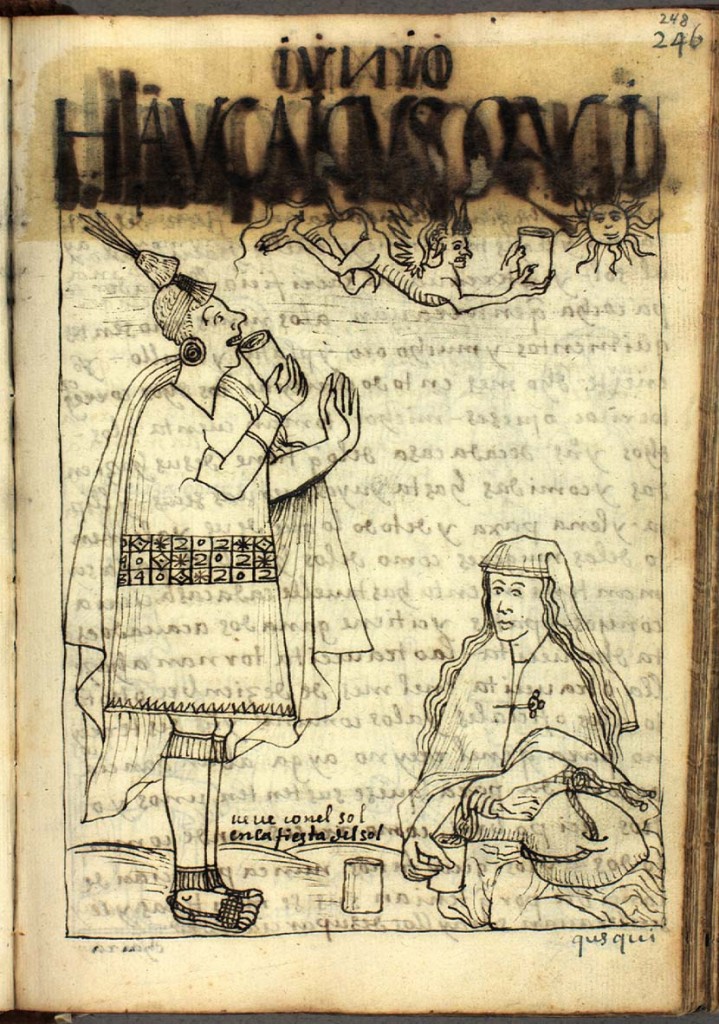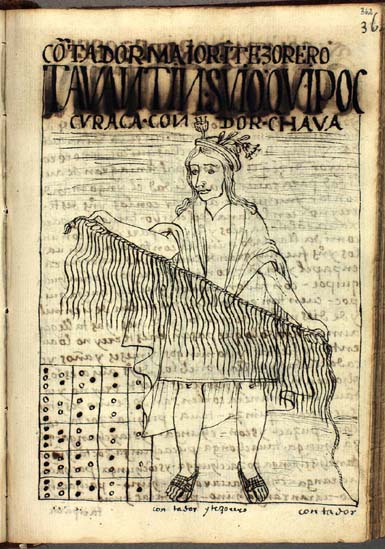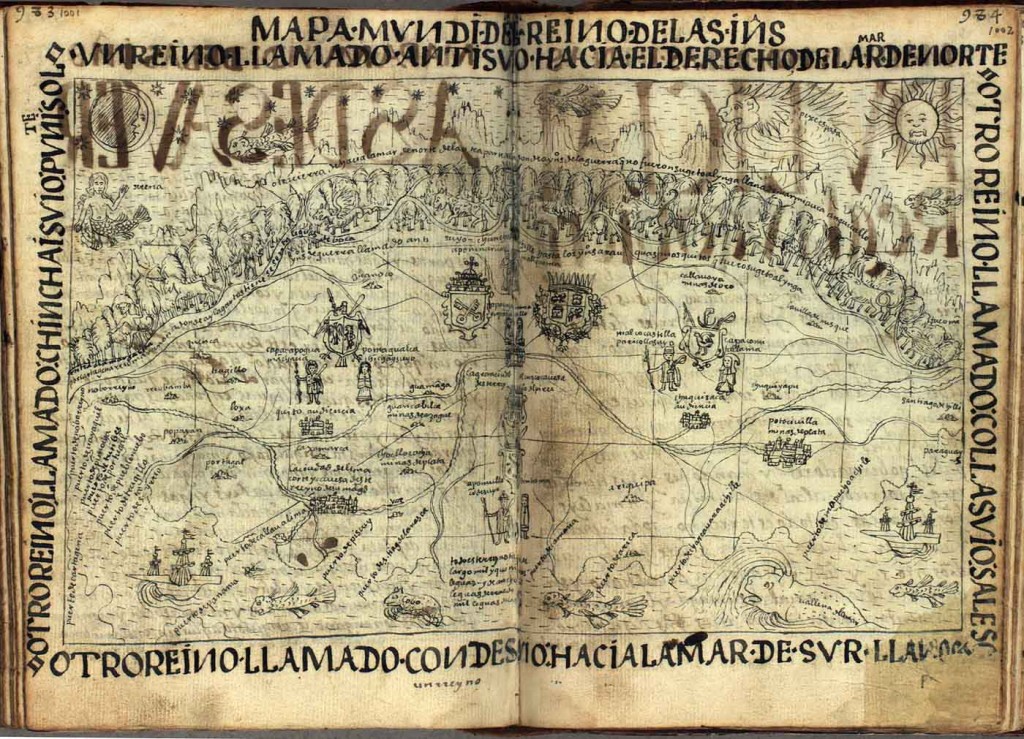PREVIOUS:
Data on dates, time, visibility and other on this link: Full Moon and Total Lunar Eclipse | December 10 2011 | The Overflow
Year 1615, April 15 precisely, the first energies of Lunar Eclipse from SAROS family 135 reach the Earth, which return this December 10, 2011, bringing along the cyclical patterns of The Overflow.
As explained when announcing Full Moon for December 10, The Overflow is what no longer is contained, nor stopped and spreads with huge outreach, even beyond time and space, and is above any consideration acquiring a life of its own which depending on the moment will have different interpretations and impacts. And, besides that, The Overflow is not the event or fact itself, it comes implicit, sometimes coded, and it’s hardly mentioned.
:::
Primera Nueva Corónica y Buen Gobierno
1615, Lima, Guamán Poma de Ayala finishes writing one of the longest letters we know, so long that besides its one thousand and eighty pages, three hundred and ninety drawings and the half century it took to write it, three more centuries will pass before it reaches publich light, officially it will be ‘lost’ for 300 years.
When it appears publicly, 1908, in Denmark, a never ending process will start until our days, about what the work is and is not, historical considerations, linguistic, artistic, scientific and other disciplines, revisions, consistencies, verifications, even on the authenticity of the manuscript and the introduction of doubts if Guamán Poma de Ayala existed or not, or if it was the pseudonym of a Jesuit…
 Specifically on the work, usually these descriptions run around: Narration on life and customs on Peru Viceroyalty from XVI century; request of an indigenous to King Felipe II to stop mistreatment of indigenous peoples; narration of pre-colonial customs in Andean territories; denounciation of injustice committed by conquerors on territorial and gender ‘Indies’; resistance literature. There are those that place the author in social struggle and indigenous rebellion, or see Guamán as the first activist denouncing the atrocities of those times.
Specifically on the work, usually these descriptions run around: Narration on life and customs on Peru Viceroyalty from XVI century; request of an indigenous to King Felipe II to stop mistreatment of indigenous peoples; narration of pre-colonial customs in Andean territories; denounciation of injustice committed by conquerors on territorial and gender ‘Indies’; resistance literature. There are those that place the author in social struggle and indigenous rebellion, or see Guamán as the first activist denouncing the atrocities of those times.
Above considerations and research, what the work is for each one or what the author had been, and even guidelines so our undestanding understands what the understanding of others want us to understand, neither in 1615 nor 300 years later, did anyone spoke about a process overflowing from its pages and breaking established canons for ‘conquered’ peoples which were being ‘civilized’ to forget who they were.
The ‘New Corónica’ coded on its drawings Andean knowledge, science and technology pulling down such convenient myths such as peoples without writing, Sun ‘worshippers’ and inferior people on ‘evolutive’ capacities comparing to those of their ‘conquerors’. Drawings waking up the asleep memory of the observer and reactivating lethargic knowledge with pre-colonial mind patterns, which lasted until our days, where they are just starting to reactivate the historical memory of the peoples who are breaking the ‘mono-reality’ and the uni-dimensional exclusivism.
 There, we find the basis of that knowledge, science and technology which many fear and do not cease to attempt silencing through disdain and scorn, but The Overflow is unstoppable and many are still watching how after the Primera Corónica y Buen Gobierno codes inscribed through drawn or sculpted signs are still emerging through multiple languages, plural meanings and related to natural laws and the Wheel of Life.
There, we find the basis of that knowledge, science and technology which many fear and do not cease to attempt silencing through disdain and scorn, but The Overflow is unstoppable and many are still watching how after the Primera Corónica y Buen Gobierno codes inscribed through drawn or sculpted signs are still emerging through multiple languages, plural meanings and related to natural laws and the Wheel of Life.
There is a never ending list, growing each day with coded knowledge on Guamán Poma de Ayla’s drawings (1), just to name some of them:
- Data base: Quipus (2), the ancestral computer: Yupana (3) | Tetralectic Order for Cuzco ‘ceques’, Geometric Form in the Wiracocha Route, Assimetry-Simmetry of Four and Astronomical Relation to Cuzco (4), see drawing to the right
- The little devil on the Winter Solstice drawing and its similarity with the Orion constellation, following its shape the stars of Betelgeuse, Bellatrix Orionis, las Tres Marias (The Three Sisters| The Three Kings), Saiph, Rigel Orionis and the Eridanus constellation (5), see the second drawing in this article
- Geodesic technology in “Mapamundi del Reino de las Indias” with Andean geographic coordinates and the South on top: Our North is the South, but also outlining the ‘Wiracocha Route’ or the Qhapaj Ñam (6) see the map on this article
- Paleography and the Tocapus (geometrical designs in textiles) (2) and (7)
- Telecommunications System through which they ruled almost on real time the Tawantinsuyo territories (8)
References
- El Sitio de Guamán Poma, Centro digital de investigación de la Biblioteca Real de Dinamarca, Copenhague
- Carlos Milla Villena: “Génesis de la Cultura Andina”, Ediciones Amaru Wayra, 2005, Lima Perú | Carlos Milla Villena: “Ayni”, Ediciones Amaru Wayra, Lima, Perú 2007
- 3. Oscar Pacheco Ríos: “Del Quipu Incaico a la Yupana, El Computador Ancestral”, Serie Etnogeometría para la Etnomatemática No. 2, Editorial CEPDI, Santa Cruz de la Sierra, Bolivia, Septiembre 1999
- Jorge Emilio Molina: “Conexión Aymara y Quechua con Tiwanaku”, Universidad Pública de El ALto, La Paz, Bolivia 2002
- Idem 2
- Idem 2
- Idem 2 y Margarita E. Gentile: “Tocapu: unidad de sentido en el lenguaje gráfico andino”, Espéculo, Revista de estudios Literarios, Universidad Complutense de Madrid, 2010
- Lucho Cabrejo: “La Estrategia de Telecomunicaciones Incaicas”
Read also:
